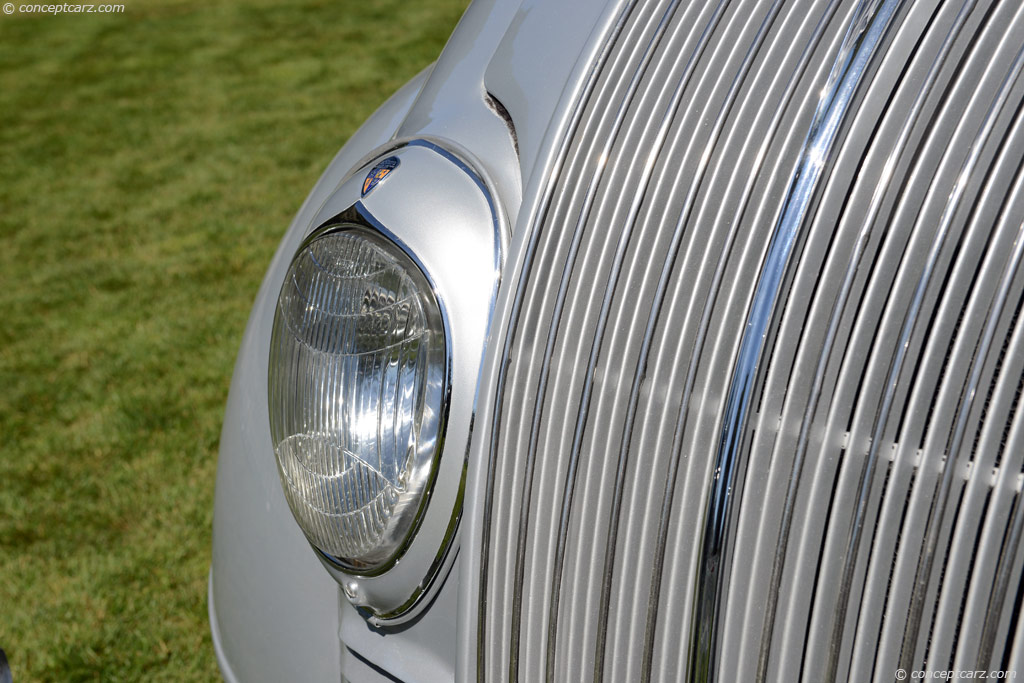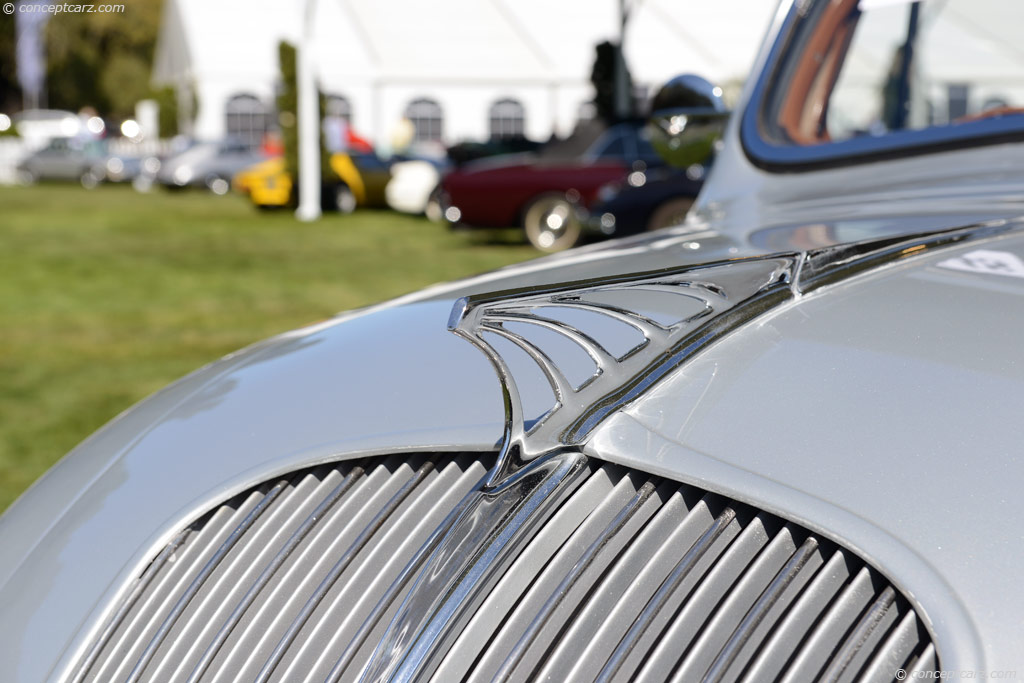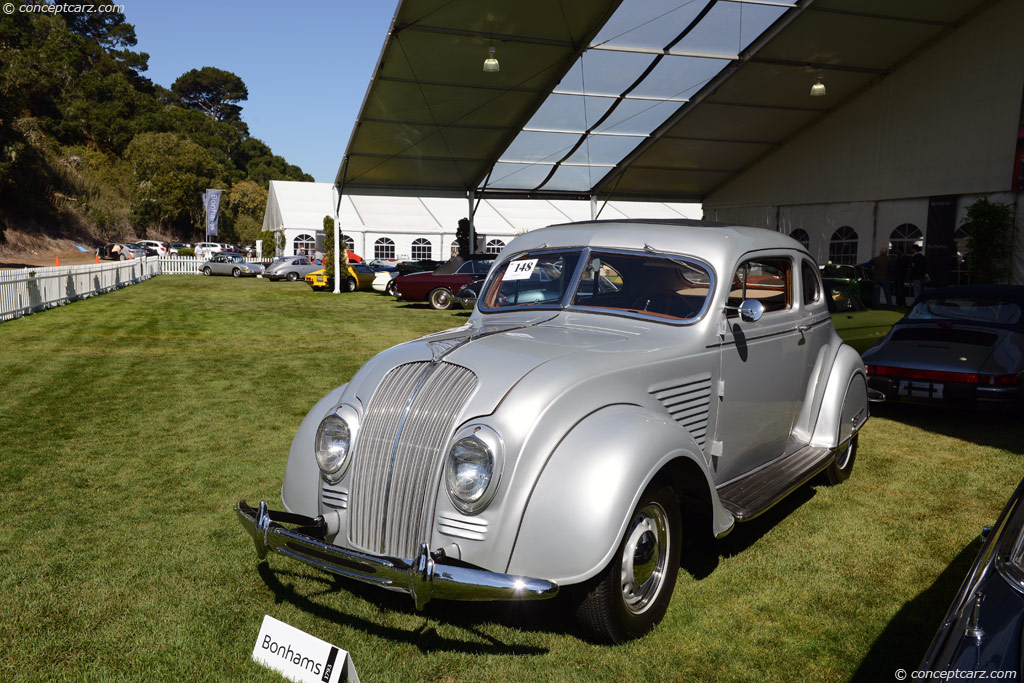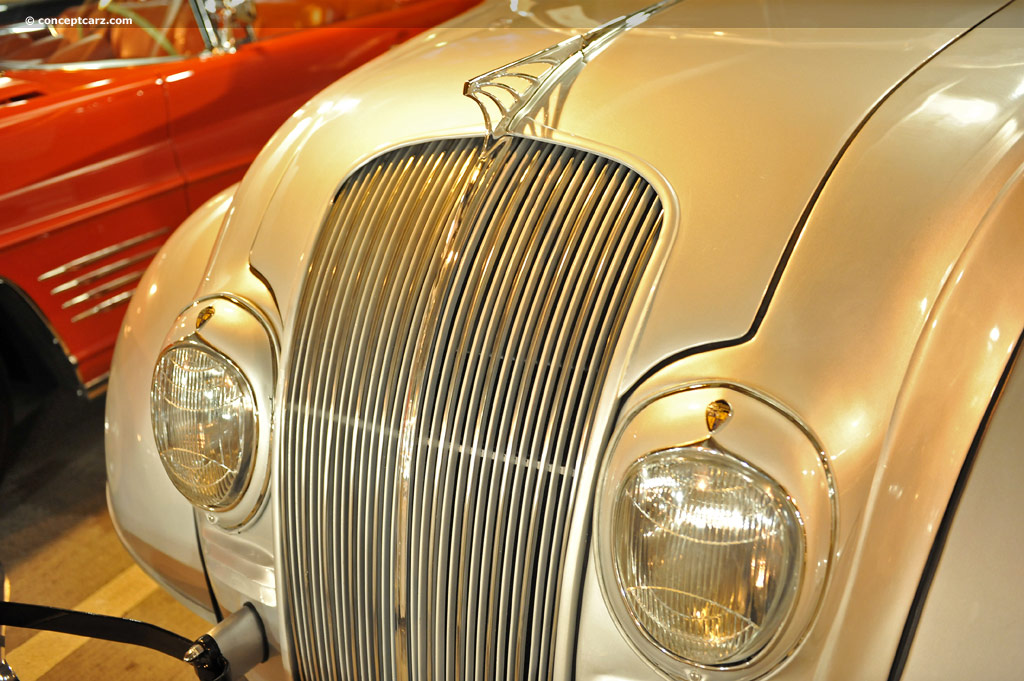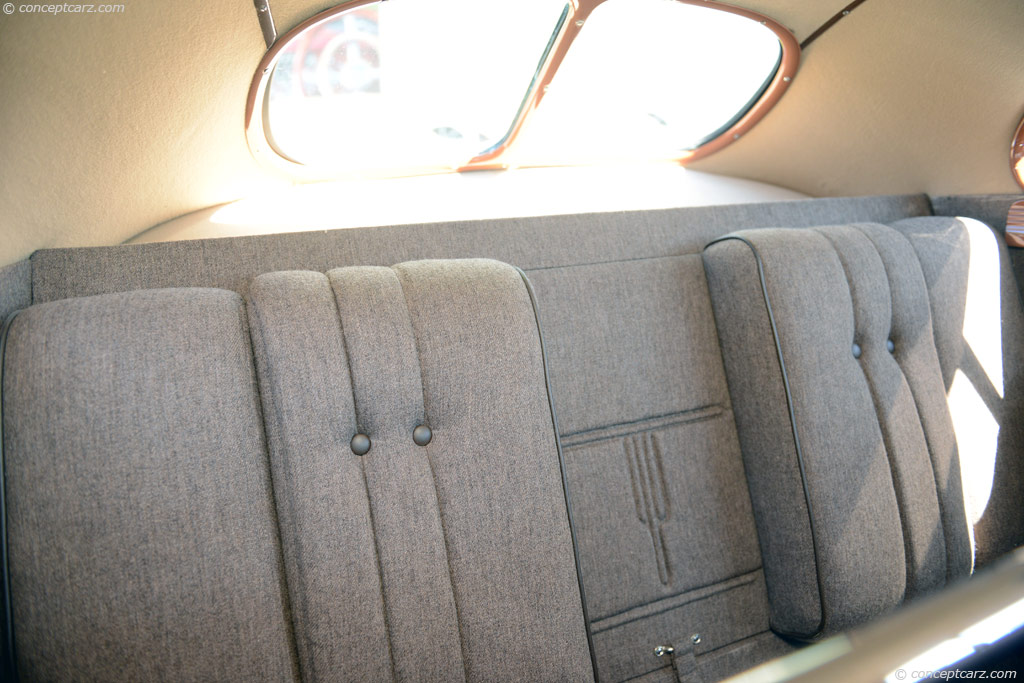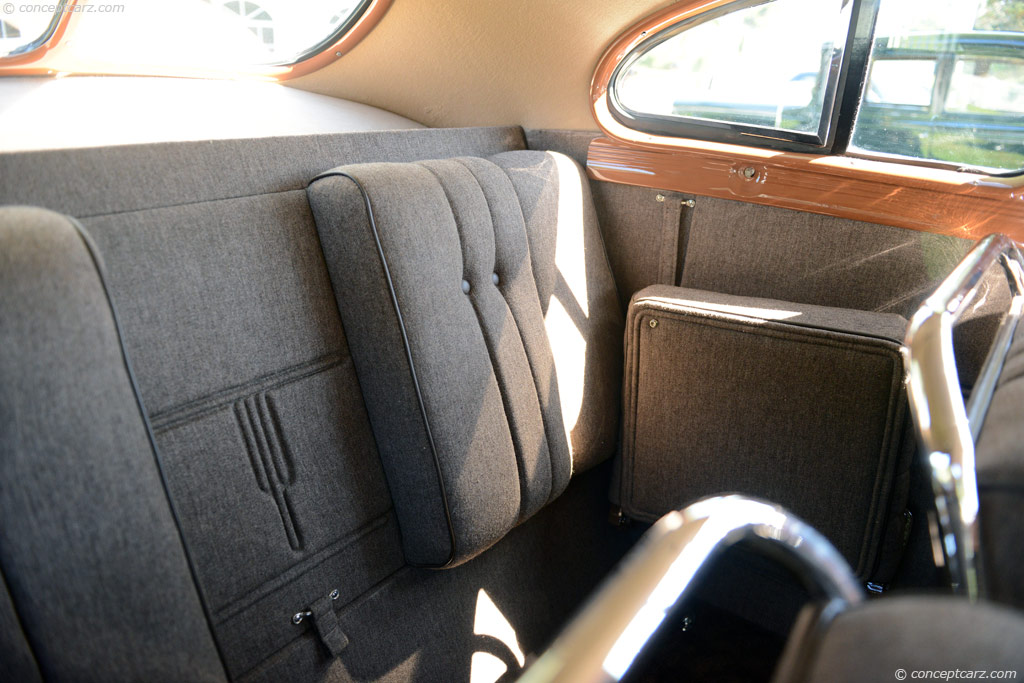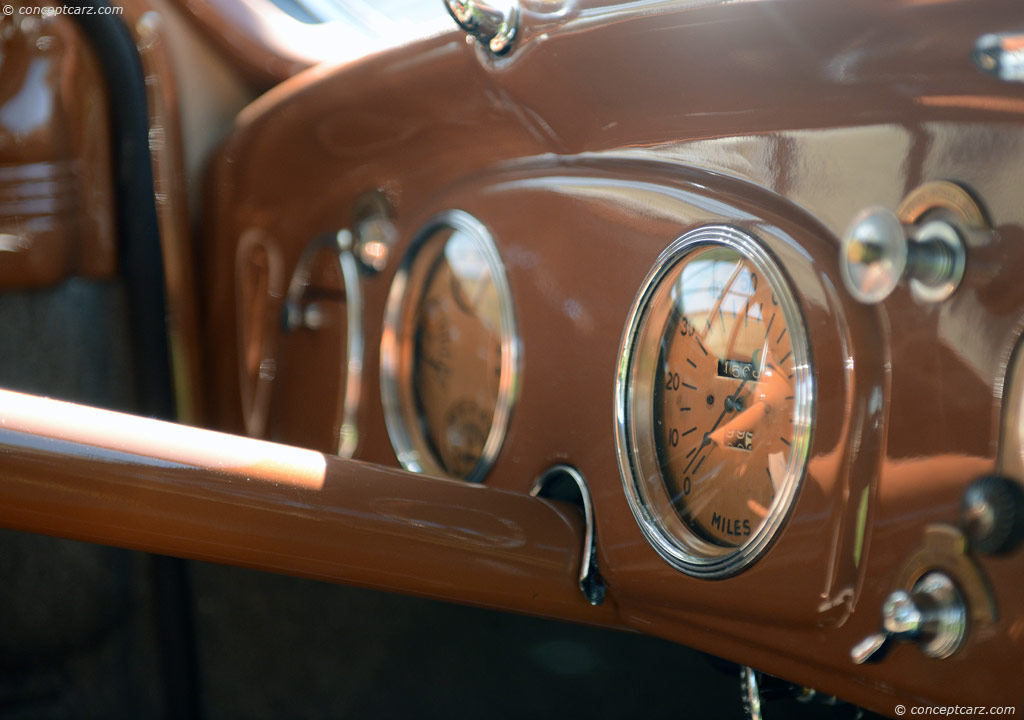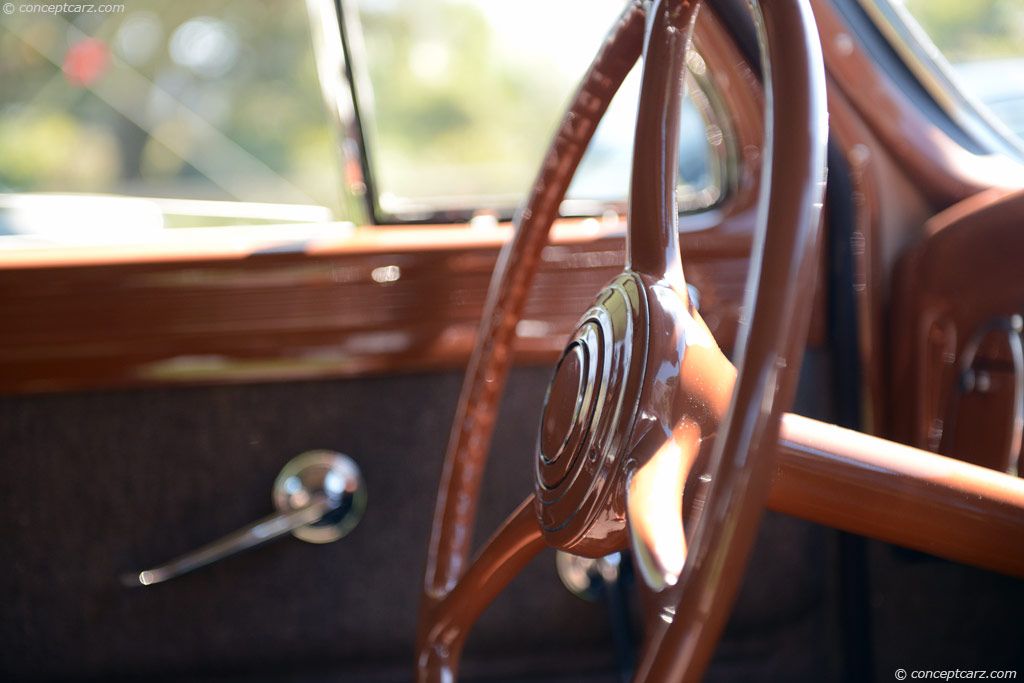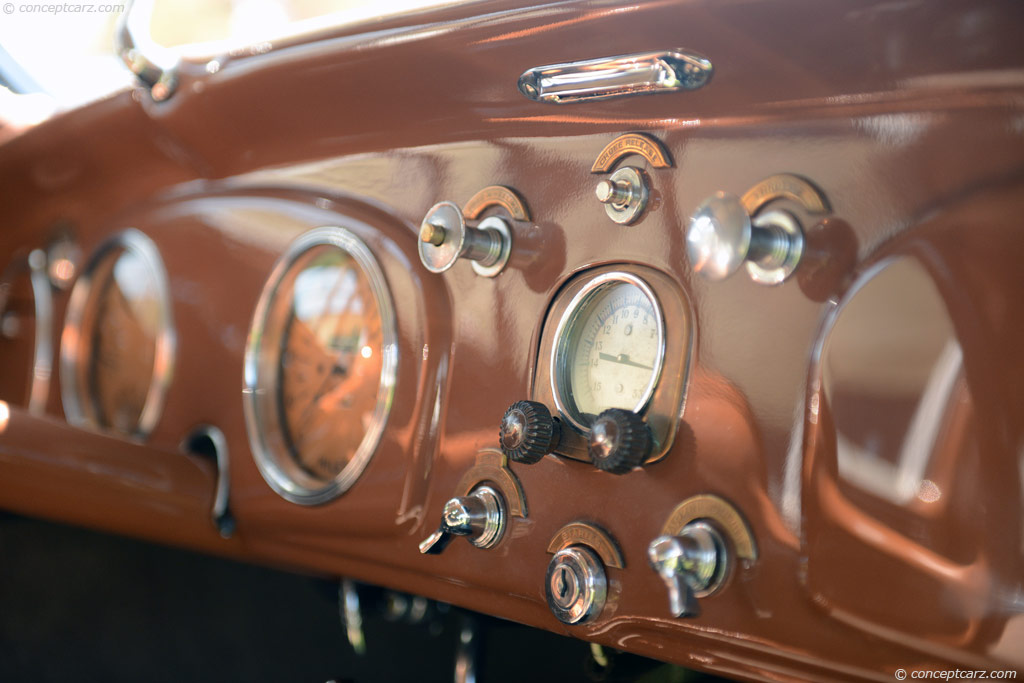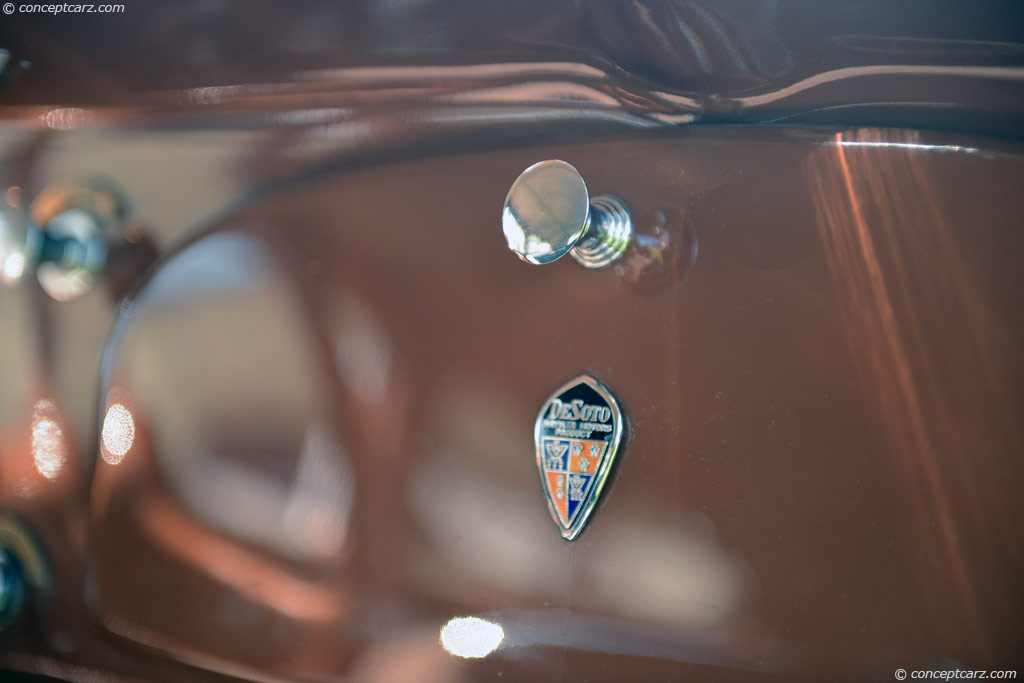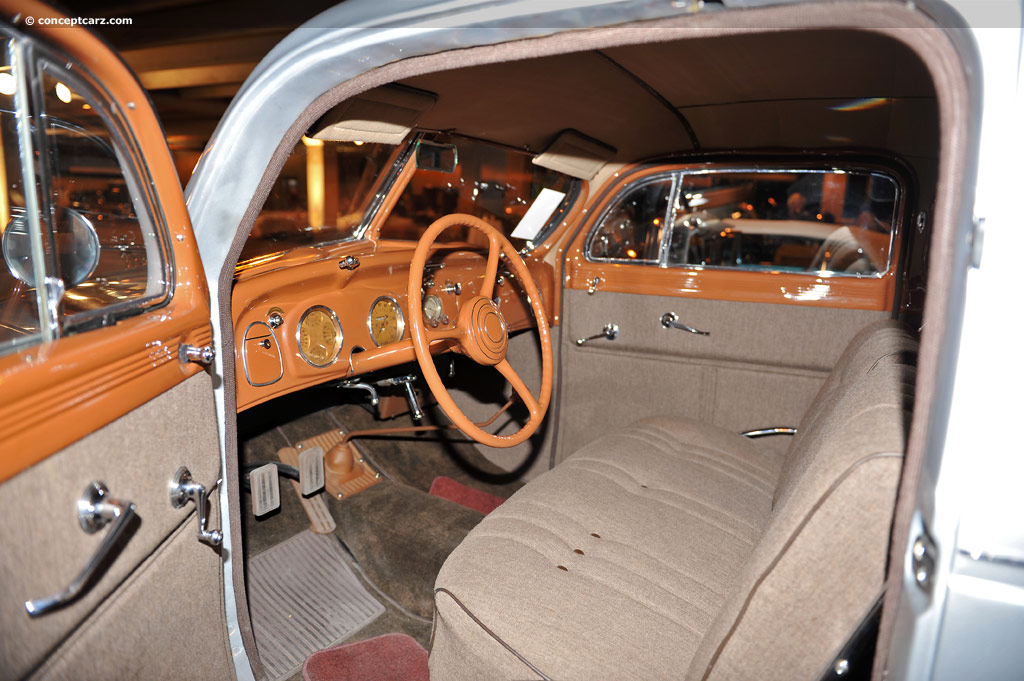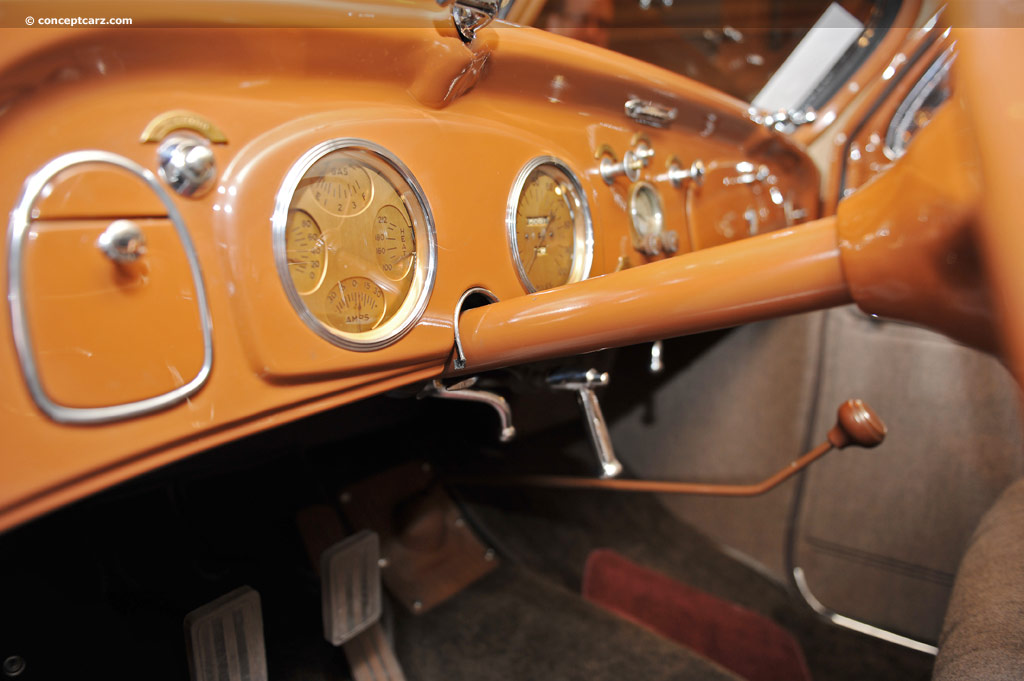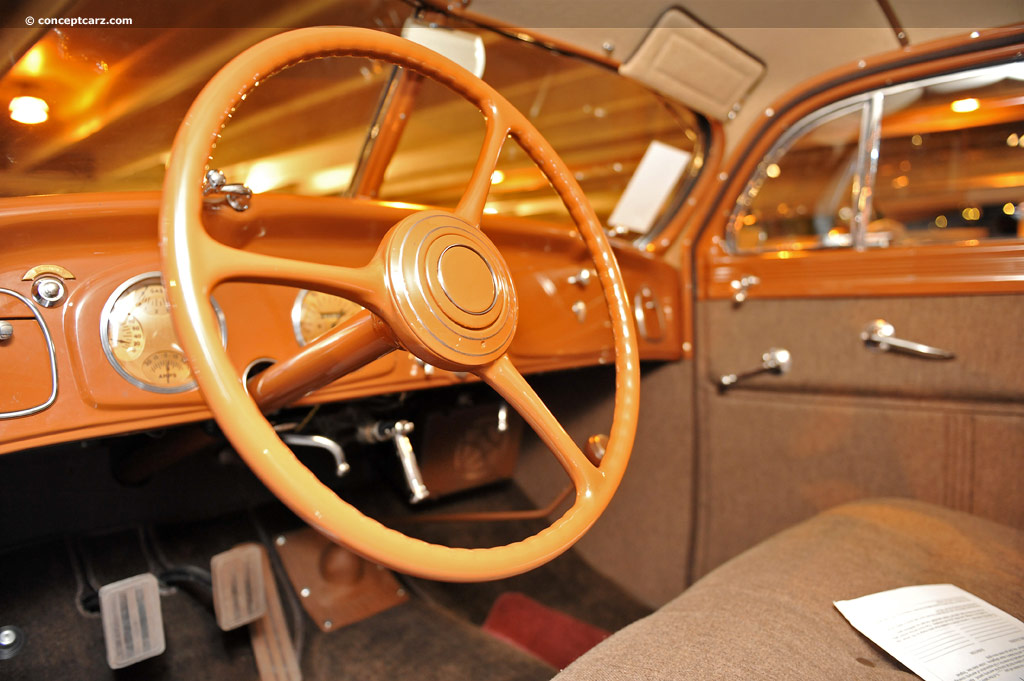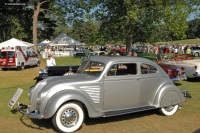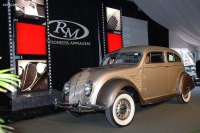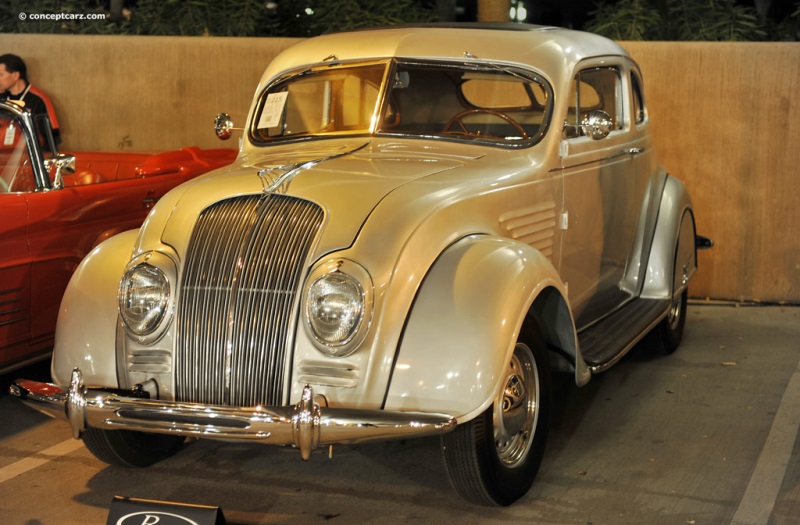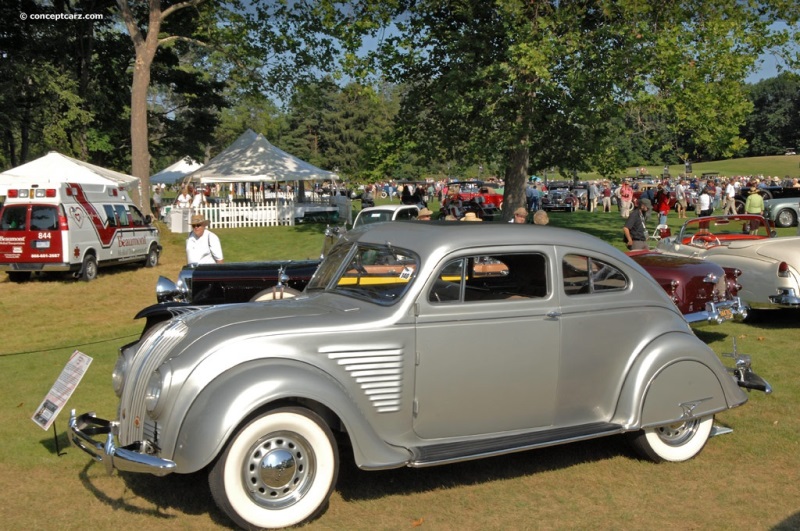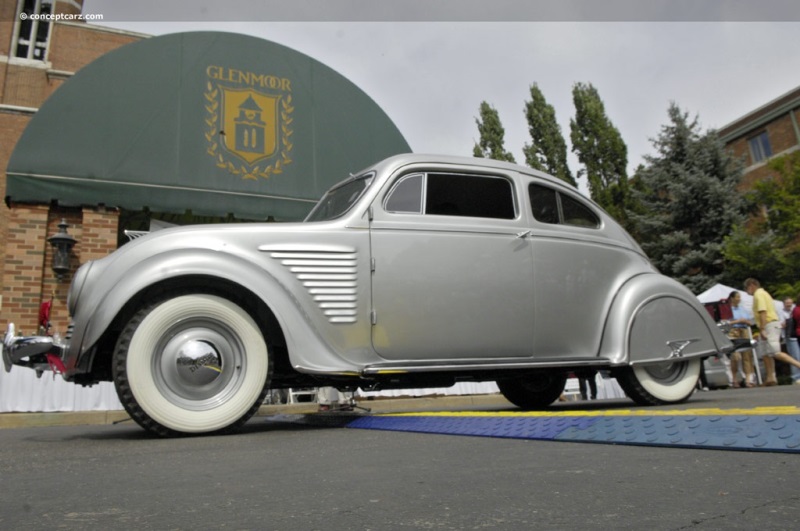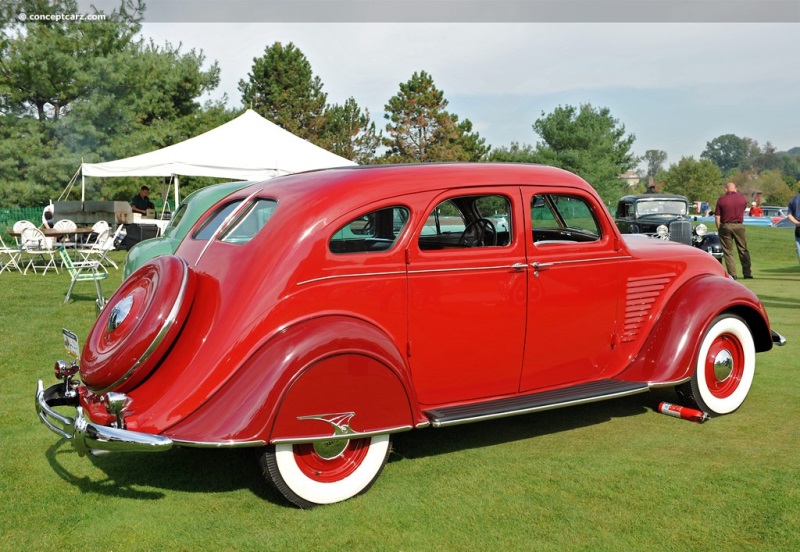Image credit: © conceptcarz.com (Reproduction Or reuse prohibited).
At the turn of the 20th century, little concern was placed on aerodynamics. Most of the vehicles designed and built were nothing more than big, abrupt cars that were about as concerned about airflow as they were about gas mileage. However, just as birds in flight birthed flight, it would also lead to a fundamental change in automotive design, and it would be embodied in the failed Chrysler Airflow.
The first American full-size car to utilize aerodynamic streamlining would find its beginnings during the late 1920s. At that time, Carl Breer worked as an engineer for Chrysler and was curious about the flow of forms through the air. This curiosity came from watching geese flying in their familiar 'V' formation. Such inquisitive observations had formed the basis for the fundamentals of flight that would come to be realized first with gliders and then in powered flight with the Wright brothers. Interestingly, as Breer came to investigate aerodynamics more closely, he worked in cooperation with Orville Wright.
By the time Breer showed interest in the flow of objects through the air the airplane had been around for a couple of decades. And as he watched some military aircraft on maneuvers, his interest became peeked. This would lead Breer and a couple of other engineers to visit Orville Wright to study the brothers' wind tunnel.
Breer would meet with Wright, and the two would take different shapes and place them within the wind tunnel so that Breer could witness how those shapes reacted. This experience would lead Chrysler to build its own wind tunnel at its Highland Park location. This wind tunnel results gave birth to Chrysler's streamlined Airflow.
One of the by-products of the wind tunnel tests would be in the very construction of cars itself. Since certain shapes obviously had different effects in airflow, it would be advantageous to construct bodies that would be able to keep those most aerodynamically shaped and make them strong enough to handle everyday use. At the time, two-box automobile design was the norm. However, wind tunnel test would give birth to monocoque designs that meant unibody construction. This would make vehicles much more streamlined thereby reducing the overall drag of the car.
The wind tunnel testing that led to the unibody design, like the Airflow, also led to another favorable attribute—better handling. Car construction of the day placed the majority of the weight, including the engine and the passengers, toward the rear axle. This made the vehicles much more unsafe in bad weather. However, the streamlined body-styling of the unibody design would move the weight toward the middle between the two axles. This also moved the engine further forward and used the weight of passengers to even out the car's weight balance. This translated into a car that handled much better and had superior driving characteristics in bad weather. It also made for a much smoother ride as there wasn't the bouncing that was normal on cars, with most of the weight positioned further back.
In 1934, Chrysler introduced a car like no other American car at that time. In January of 1934, months before the car would actually be made available, Chrysler would debut its Airflow. Not only would the construction, layout, and method be unlike any other American car at that time, but its design would also be from a wholly different era. At a time when the other major manufacturers were still using wood framing members, Chrysler would come along with a car that had a stronger structure and a design that, when compared to other cars of the time, looked incredibly sleek and flowing. Besides front fenders that enclosed the front wheels, the Airflow would be one of the first cars of its time to enclose the rear wheels as well, especially with something like fender skirts. The car was absolutely revolutionary. And its performance was revolutionary as well.
DeSoto was something of a junior company within the Chrysler family. And in 1934, DeSoto offered nothing but the new streamlined car while Chrysler still built and offered some of its cars from the 1933 line along with the Airflow. Featuring its sleek design with its downward sweeping front grille reminiscent of a waterfall, inset headlights and raked 'V' windshield Walter Chrysler was convinced the Airflow would sell in large numbers.
However, it was not to be. Proving that old habits die hard and that change is difficult, the public would step away from the futuristic car. What made the car special would be the very thing that would make people shy away from it.
It wouldn't necessarily be the car's fault that people were unimpressed with the car. In fact, the car would be very impressive and would prove aerodynamics in car design. Harry Hartz would perform a cross-country trip in an Airflow. Traveling from New York to San Francisco, Hartz would average an unprecedented 22 miles per gallon. By the summer of 1934, the Airflow would break more than 70 national and international records at the Bonneville Salt Flats. The car, during a 24-hour non-stop run, would average better than 84 mph and would even touch speeds of 95 mph. The DeSoto model would also be impressive, setting records by achieving an average speed in excess of 76 mph over 500 miles and over 74 mph for 2,000 miles. Yet despite the records, it would be the fact the car was ahead of its time that potential buyers would avoid the car.
While Chrysler would actually make money throughout the 1934 model year because of the older line of cars, DeSoto would be hurting offered just the 'new-fangled' Airflow. In addition, the DeSoto model looked rather short and stumpy compared to the larger wheelbase Chrysler model. Combining the revolutionary looks with a shorter wheelbase was a formula for disaster.
The lack of interest in the car would lead to designers applying touches of the old to help mute the revolutionary. The biggest and most noticeable change to the 1935 model would be the inclusion of a peaked grille. This appeared like an older, more classic, design acting like the heart and the soul of the new car.
Along with the Airflow, the Airstream would be introduced by Chrysler and DeSoto. And while the Airstream would earn decent sales, the Airflow would continue to slip in sales. Chrysler would try for another couple of years to keep the design going in the hopes that sales would take off. And while an Airflow Custom Imperial model limousine would be made for Philippine president Manuel Quezon as his official state car, the Airflow would come to an end at the end of 1937.
The reality was, however, the car worked. The principles of aerodynamics are irrefutable. And while the public may have refuted them, or at least the way in which they were packaged, every other car manufacturer knew the truth. Therefore, it would not be surprising the legacy the Airflow would leave behind.
While the Airflow may have only been produced for about three short years, its influence on car design would be almost immediate and would also be forever. In 1936, Toyota unveiled its AA model which looked very similar to the Airflow. Volvo's Carioca would certainly have elements drawn from the Airflow. It would even be rumored that Ferdinand Porsche had an Airflow brought to Germany to use as a tool of 'inspiration'. Many believe this to be true given the Volkswagen design similarities to the Airflow.
One of the influential Airflows would be up for auction in 2012 at the RM Auction in Arizona. The model would be a DeSoto Airflow Coupe that was produced in 1934, the first year of the Airflow.
Chassis 6078798 would be just one of 1,520 DeSoto Airflow coupes that would be built during 1934. The Great Depression was still at its height and it would also influence purchasers to look for practicality instead of revolutionary design. But what the people didn't realize is that the revolutionary design of the Airflow, like the DeSoto offered at RM was about as practical as one could get.
While this chassis would already be just one of a little more than 1500 DeSoto Airflow coupes, it would actually be one of an even fewer number. Over the years, most of the DeSoto Airflow coupes have failed to make it. This means this particular chassis is now just one of about 15 known to exist. That makes this car both rare and revolutionary.
Although this particular Airflow is just one of 15 known to exist, even fewer have actually been restored. But the rarity of this particular chassis continues to grow as it is one of those that have actually undergone restoration. In fact, the restoration is quite recent. Finished in 2010, this particular Airflow, complete with the once familiar Art Deco styling, also includes a rebuilt engine and a silver finish with a correct brown cloth interior. Of course, one of the elements of this 1934 example is the 'waterfall' grille adorning the nose of the car.
Once owned by Charles Cochran, the former president of the Airflow Club of America, this car came to auction expecting to garner between $50,000 and $75,000.
It's the foolish things that confound the wise, and the Airflow, which many thought foolish in its looks, would go on to influence designs from the very moment it was unveiled to the public. Truly a modern marvel, the Airflow is an important car for any collection simply because of the influence it would have on the automotive industry throughout the decades.
Sources:
'Feature Lots: Lot No. 215: 1934 DeSoto Airflow Coupe', (http://www.rmauctions.com/FeatureCars.cfm?SaleCode=AZ12&CarID=r172&fc=0). RM Auction. http://www.rmauctions.com/FeatureCars.cfm?SaleCode=AZ12&CarID=r172&fc=0. Retrieved 10 January 2012.
'Classic & Collectible: 1930s: 1934-1937 Chrysler/DeSoto Airflow', (http://auto.howstuffworks.com/1934-1937-chrysler-desoto-airflow8.htm). HowStuffWorks: You May Know the Half of it. We Know the Other Half. http://auto.howstuffworks.com/1934-1937-chrysler-desoto-airflow8.htm. Retrieved 10 January 2012.
'1936 DeSoto Airflow Coupe', (http://www.significantcars.com/cars/1936desoto/index.html). SignificantCars.com. http://www.significantcars.com/cars/1936desoto/index.html. Retrieved 10 January 2012.
Wikipedia contributors, 'Chrysler Airflow', Wikipedia, The Free Encyclopedia, 13 December 2011, 00:06 UTC, http://en.wikipedia.org/w/index.php?title=Chrysler_Airflow&oldid=465546545 accessed 10 January 2012
By Jeremy McMullen
The first American full-size car to utilize aerodynamic streamlining would find its beginnings during the late 1920s. At that time, Carl Breer worked as an engineer for Chrysler and was curious about the flow of forms through the air. This curiosity came from watching geese flying in their familiar 'V' formation. Such inquisitive observations had formed the basis for the fundamentals of flight that would come to be realized first with gliders and then in powered flight with the Wright brothers. Interestingly, as Breer came to investigate aerodynamics more closely, he worked in cooperation with Orville Wright.
By the time Breer showed interest in the flow of objects through the air the airplane had been around for a couple of decades. And as he watched some military aircraft on maneuvers, his interest became peeked. This would lead Breer and a couple of other engineers to visit Orville Wright to study the brothers' wind tunnel.
Breer would meet with Wright, and the two would take different shapes and place them within the wind tunnel so that Breer could witness how those shapes reacted. This experience would lead Chrysler to build its own wind tunnel at its Highland Park location. This wind tunnel results gave birth to Chrysler's streamlined Airflow.
One of the by-products of the wind tunnel tests would be in the very construction of cars itself. Since certain shapes obviously had different effects in airflow, it would be advantageous to construct bodies that would be able to keep those most aerodynamically shaped and make them strong enough to handle everyday use. At the time, two-box automobile design was the norm. However, wind tunnel test would give birth to monocoque designs that meant unibody construction. This would make vehicles much more streamlined thereby reducing the overall drag of the car.
The wind tunnel testing that led to the unibody design, like the Airflow, also led to another favorable attribute—better handling. Car construction of the day placed the majority of the weight, including the engine and the passengers, toward the rear axle. This made the vehicles much more unsafe in bad weather. However, the streamlined body-styling of the unibody design would move the weight toward the middle between the two axles. This also moved the engine further forward and used the weight of passengers to even out the car's weight balance. This translated into a car that handled much better and had superior driving characteristics in bad weather. It also made for a much smoother ride as there wasn't the bouncing that was normal on cars, with most of the weight positioned further back.
In 1934, Chrysler introduced a car like no other American car at that time. In January of 1934, months before the car would actually be made available, Chrysler would debut its Airflow. Not only would the construction, layout, and method be unlike any other American car at that time, but its design would also be from a wholly different era. At a time when the other major manufacturers were still using wood framing members, Chrysler would come along with a car that had a stronger structure and a design that, when compared to other cars of the time, looked incredibly sleek and flowing. Besides front fenders that enclosed the front wheels, the Airflow would be one of the first cars of its time to enclose the rear wheels as well, especially with something like fender skirts. The car was absolutely revolutionary. And its performance was revolutionary as well.
DeSoto was something of a junior company within the Chrysler family. And in 1934, DeSoto offered nothing but the new streamlined car while Chrysler still built and offered some of its cars from the 1933 line along with the Airflow. Featuring its sleek design with its downward sweeping front grille reminiscent of a waterfall, inset headlights and raked 'V' windshield Walter Chrysler was convinced the Airflow would sell in large numbers.
However, it was not to be. Proving that old habits die hard and that change is difficult, the public would step away from the futuristic car. What made the car special would be the very thing that would make people shy away from it.
It wouldn't necessarily be the car's fault that people were unimpressed with the car. In fact, the car would be very impressive and would prove aerodynamics in car design. Harry Hartz would perform a cross-country trip in an Airflow. Traveling from New York to San Francisco, Hartz would average an unprecedented 22 miles per gallon. By the summer of 1934, the Airflow would break more than 70 national and international records at the Bonneville Salt Flats. The car, during a 24-hour non-stop run, would average better than 84 mph and would even touch speeds of 95 mph. The DeSoto model would also be impressive, setting records by achieving an average speed in excess of 76 mph over 500 miles and over 74 mph for 2,000 miles. Yet despite the records, it would be the fact the car was ahead of its time that potential buyers would avoid the car.
While Chrysler would actually make money throughout the 1934 model year because of the older line of cars, DeSoto would be hurting offered just the 'new-fangled' Airflow. In addition, the DeSoto model looked rather short and stumpy compared to the larger wheelbase Chrysler model. Combining the revolutionary looks with a shorter wheelbase was a formula for disaster.
The lack of interest in the car would lead to designers applying touches of the old to help mute the revolutionary. The biggest and most noticeable change to the 1935 model would be the inclusion of a peaked grille. This appeared like an older, more classic, design acting like the heart and the soul of the new car.
Along with the Airflow, the Airstream would be introduced by Chrysler and DeSoto. And while the Airstream would earn decent sales, the Airflow would continue to slip in sales. Chrysler would try for another couple of years to keep the design going in the hopes that sales would take off. And while an Airflow Custom Imperial model limousine would be made for Philippine president Manuel Quezon as his official state car, the Airflow would come to an end at the end of 1937.
The reality was, however, the car worked. The principles of aerodynamics are irrefutable. And while the public may have refuted them, or at least the way in which they were packaged, every other car manufacturer knew the truth. Therefore, it would not be surprising the legacy the Airflow would leave behind.
While the Airflow may have only been produced for about three short years, its influence on car design would be almost immediate and would also be forever. In 1936, Toyota unveiled its AA model which looked very similar to the Airflow. Volvo's Carioca would certainly have elements drawn from the Airflow. It would even be rumored that Ferdinand Porsche had an Airflow brought to Germany to use as a tool of 'inspiration'. Many believe this to be true given the Volkswagen design similarities to the Airflow.
One of the influential Airflows would be up for auction in 2012 at the RM Auction in Arizona. The model would be a DeSoto Airflow Coupe that was produced in 1934, the first year of the Airflow.
Chassis 6078798 would be just one of 1,520 DeSoto Airflow coupes that would be built during 1934. The Great Depression was still at its height and it would also influence purchasers to look for practicality instead of revolutionary design. But what the people didn't realize is that the revolutionary design of the Airflow, like the DeSoto offered at RM was about as practical as one could get.
While this chassis would already be just one of a little more than 1500 DeSoto Airflow coupes, it would actually be one of an even fewer number. Over the years, most of the DeSoto Airflow coupes have failed to make it. This means this particular chassis is now just one of about 15 known to exist. That makes this car both rare and revolutionary.
Although this particular Airflow is just one of 15 known to exist, even fewer have actually been restored. But the rarity of this particular chassis continues to grow as it is one of those that have actually undergone restoration. In fact, the restoration is quite recent. Finished in 2010, this particular Airflow, complete with the once familiar Art Deco styling, also includes a rebuilt engine and a silver finish with a correct brown cloth interior. Of course, one of the elements of this 1934 example is the 'waterfall' grille adorning the nose of the car.
Once owned by Charles Cochran, the former president of the Airflow Club of America, this car came to auction expecting to garner between $50,000 and $75,000.
It's the foolish things that confound the wise, and the Airflow, which many thought foolish in its looks, would go on to influence designs from the very moment it was unveiled to the public. Truly a modern marvel, the Airflow is an important car for any collection simply because of the influence it would have on the automotive industry throughout the decades.
Sources:
'Feature Lots: Lot No. 215: 1934 DeSoto Airflow Coupe', (http://www.rmauctions.com/FeatureCars.cfm?SaleCode=AZ12&CarID=r172&fc=0). RM Auction. http://www.rmauctions.com/FeatureCars.cfm?SaleCode=AZ12&CarID=r172&fc=0. Retrieved 10 January 2012.
'Classic & Collectible: 1930s: 1934-1937 Chrysler/DeSoto Airflow', (http://auto.howstuffworks.com/1934-1937-chrysler-desoto-airflow8.htm). HowStuffWorks: You May Know the Half of it. We Know the Other Half. http://auto.howstuffworks.com/1934-1937-chrysler-desoto-airflow8.htm. Retrieved 10 January 2012.
'1936 DeSoto Airflow Coupe', (http://www.significantcars.com/cars/1936desoto/index.html). SignificantCars.com. http://www.significantcars.com/cars/1936desoto/index.html. Retrieved 10 January 2012.
Wikipedia contributors, 'Chrysler Airflow', Wikipedia, The Free Encyclopedia, 13 December 2011, 00:06 UTC, http://en.wikipedia.org/w/index.php?title=Chrysler_Airflow&oldid=465546545 accessed 10 January 2012
By Jeremy McMullen
2013 Bonhams - Quail Lodge Auction
Sale Price :
USD $82,500
2012 RM Auctions - Hershey, PA
Pre-Auction Estimates :
USD $55,000-USD $65,000
Sale Price :
USD $55,000
2012 RM-Automobiles of Arizona
Pre-Auction Estimates :
USD $50,000-USD $75,000
Sale Price :
USD $52,250
1934 DeSoto Airflow Auction Sales
Recent Sales of the DeSoto Airflow
(Data based on Model Year 1934 sales)
| 1934 DeSoto Series SE Airflow Sedan Chassis#: 5081471 Sold for USD$56,000 2023 Worldwide Auctioneers : The Enthusiast Auction | |
| 1934 DeSoto Airflow Chassis#: SE11863 Sold for USD$71,000 2022 GAA : November 2022 | |
| 1934 DeSoto Airflow Coupe Chassis#: 5081200 Sold for USD$113,120 2022 Worldwide Auctioneers : The Auburn Auction | |
| 1934 DeSoto Airflow Coupe Chassis#: 5071584 Sold for USD$190,400 2021 Worldwide Auctioneers : The 14th Annual Auburn Auction | |
| 1934 DeSoto Airflow Coupe Sold for USD$56,000 2017 Mecum : Indianapolis | |
| 1934 DeSoto Airflow Coupe Chassis#: 5072977 Sold for USD$68,200 2017 Gooding & Co. : Scottsdale, AZ | |
| 1934 DESOTO AIRFLOW Chassis#: SE11863 Sold for USD$41,800 2017 Barrett-Jackson : Scottsdale | |
| 1934 Desoto Airflow Sold for USD$46,000 2016 Silver Auction - Arizona in January 2016 | |
| 1934 DeSoto Airflow Coupe Chassis#: 6078798 Sold for USD$82,500 2013 Bonhams - Quail Lodge Auction |   |
| 1934 DeSoto Airflow Coupe Sold for USD$43,450 2013 Auctions America - Ft Lauderdale | |
| 1934 DeSoto Airflow Coupe Chassis#: 6078798 Sold for USD$55,000 2012 RM Auctions - Hershey, PA |   |
| 1934 DeSoto Airflow Coupe Chassis#: 6078798 Sold for USD$52,250 2012 RM-Automobiles of Arizona |   |
| 1934 DeSoto Airflow Brougham Sedan Sold for USD$51,700 2009 Collector Cars of Fort Lauderdale | |
| 1934 Desoto Airflow Sedan Sold for USD$28,600 2008 RM Auctions - Classic Car Auction of Michigan | |
| 1934 De Soto Airflow Sold for USD$52,250 2007 Vintage Motor Cars at Amelia Island |   |
DeSoto Airflows That Failed To Sell At Auction
1934 DeSoto Airflow's that have appeared at auction but did not sell.
| Vehicle | Chassis | Event | High Bid | Est. Low | Est. High |
|---|---|---|---|---|---|
| 1934 DeSoto Airflow Sedan | 2019 RM Auctions : Auburn Fall | ||||
| 1934 DeSoto Airflow Coupe | 2017 Auctions America : Auburn Spring | $50,000 | $60,000 | ||
| 1934 DeSoto Airflow Street Rod | 2016 Mecum : Dallas | $90,000 | |||
| 1934 DeSoto Airflow Street Rod | 2016 Mecum Portland | $90,000 | |||
| 1934 DeSoto Airflow Street Rod | 2016 Mecum Indianapolis |
Vehicles With Comparable Market Values
Similar sales to the $67,218 range.
| 1937 DELAHAYE TYPE 135M COMPETITION COURT CHASSIS Sold for $67,200 2024 Gooding & Co: Selections From The Mullin Collection Auction | |
| 2023 Dodge Challenger Swinger Chassis#:2c3cdzfj2ph525982 Sold for $67,100 2024 Mecum : Houston | |
| 1966 Pontiac GTO Chassis#:242176p251435 Sold for $67,100 2024 Mecum : Glendale | |
| 1933 Rover 14/6 Speed Pilot Sports Tourer Chassis#:36173 Sold for $67,200 2024 Broad Arrow Auctions : Amelia |   |
| 1962 Alfa Romeo Giulietta Sprint Speciale by Bertone Chassis#:AR177344 Sold for $67,200 2024 RM Sothebys : ModaMiami |   |
| 1981 Toyota Land Cruiser Pickup Chassis#:HJ47000689 Sold for $67,200 2024 Broad Arrow Auctions : Amelia | |
| 1979 DUCATI 900 SUPER SPORT Chassis#:DM860SS*089076* Sold for $67,200 2024 Gooding : Amelia Island Concours | |
| 1924 BUCCIALI TYPE B6 RECREATION Chassis#:C2401 Sold for $67,200 2024 Gooding : Amelia Island Concours | |
| 2010 Aston Martin V8 Vantage Coupé Chassis#:SCFEFBAC2AGC14185 Sold for $67,472 2024 Bonhams : Les Grandes Marques du Monde a Paris | |
| 1970 OLDSMOBILE 442 CUSTOM CONVERTIBLE Chassis#:344670M259960 Sold for $67,100 2024 Barrett-Jackson : Scottsdale AZ | |
| 2014 BENTLEY CONTINENTAL FLYING SPUR Chassis#:SCBEC9ZA9EC091307 Sold for $67,100 2024 Barrett-Jackson : Scottsdale AZ | |
| 1970 DODGE CHALLENGER R/T Chassis#:AZ393359 Sold for $67,100 2024 Barrett-Jackson : Scottsdale AZ | |
| 1966 CADILLAC DE VILLE CUSTOM CONVERTIBLE Chassis#:F6177406 Sold for $67,100 2024 Barrett-Jackson : Scottsdale AZ | |
| 1939 Ford Custom Convertible Chassis#:05f08261 Sold for $67,100 2024 Mecum : Kissimmee | |
| 1972 Chevrolet C10 Cheyenne Pickup Chassis#:cce142s183583 Sold for $67,100 2024 Mecum : Kissimmee | |
| 1972 Chevrolet Chevelle SS Chassis#:1d37u2r508300 Sold for $67,100 2023 Mecum : Kansas City | |
| 1957 Chevrolet Bel Air Chassis#:vc57s243353 Sold for $67,100 2023 Mecum : Chattanooga | |
| 2010 Bentley Continental Supersports Chassis#:scbcu8za0ac064022 Sold for $67,100 2023 Mecum : Chattanooga | |
| 1970 Alfa Romeo 'Autotutto' F11 Minibus Chassis#:AR*990137* Sold for $66,854 2023 Bonhams : The Zoute Sale | |
| 1931 Packard 840 Deluxe Eight Convertible Coupe Sold for $67,100 2023 RM Sothebys : Hershey |   |
1934 DeSoto Airflow
• Additional valuation insight and sales data• History
• Specifications
• Image gallery
• Other DeSoto Airflow model years

